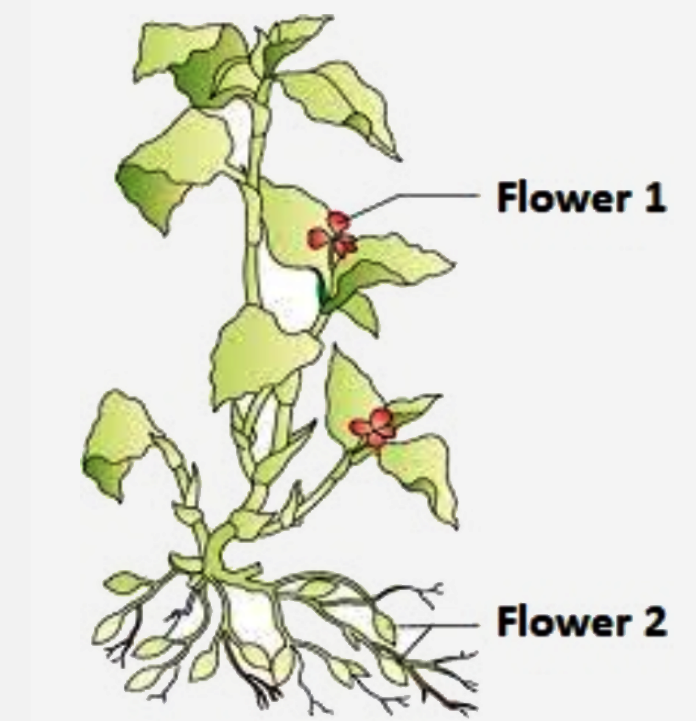Pollination is an important phenomenon in the life cycle of a flowering plant. Describe the agencies responsible for this.
Step-by-Step Solution:
1. Understanding Pollination:
- Pollination is the transfer of pollen grains from the anther (the male part of the flower) to the stigma (the female part of the flower). This process is crucial for fertilization to occur, leading to the development of seeds and fruits.
2. Importance of Pollination:
- Without pollination, fertilization cannot take place. The male gametes in the pollen grains must fuse with the egg cell to form a zygote. This zygote will eventually develop into a seed, and the ovary will develop into a fruit. Therefore, pollination is essential for the continuation of the plant's life cycle.
3. Agencies Responsible for Pollination:
- Pollination agents can be categorized into two main types: Abiotic (non-living) and Biotic (living).
4. Abiotic Agents:
- Wind (Anemophily):
- Wind is a significant abiotic agent that carries pollen grains from one flower to another. Examples include maize and sugarcane.
- Water (Hydrophily):
- In some aquatic plants, water acts as a medium for pollen transfer. An example is *Wellisneria*.
5. Biotic Agents:
- Insects (Entomophily):
- Insects, especially bees, are crucial for pollination. They transfer pollen from the anther to the stigma while foraging for nectar. Examples include *Salvia* and various species of orchids.
- Birds (Ornithophily):
- Birds also play a role in pollination. They transfer pollen while feeding on nectar. An example is *Bignonia*.
- Bats (Xeropterophily):
- Some plants are pollinated by bats, which are attracted to flowers that bloom at night. Examples include *Kigelia pinnata* and *Adansonia*.
- Slugs and Snails (Malacophily):
- These creatures can also contribute to pollination. An example is *Chrysanthemum*.
- Ants (Myrmecophily):
- Some plants are pollinated by ants, which can carry pollen as they move. An example is *Anemone*.
Summary:
Pollination is facilitated by various agents, both abiotic (like wind and water) and biotic (like insects, birds, bats, slugs, and ants). Each agent plays a unique role in ensuring the successful reproduction of flowering plants.
---
- Pollination is the transfer of pollen grains from the anther (the male part of the flower) to the stigma (the female part of the flower). This process is crucial for fertilization to occur, leading to the development of seeds and fruits.
- Without pollination, fertilization cannot take place. The male gametes in the pollen grains must fuse with the egg cell to form a zygote. This zygote will eventually develop into a seed, and the ovary will develop into a fruit. Therefore, pollination is essential for the continuation of the plant's life cycle.
- Pollination agents can be categorized into two main types: Abiotic (non-living) and Biotic (living).
- Wind (Anemophily):
- Wind is a significant abiotic agent that carries pollen grains from one flower to another. Examples include maize and sugarcane.
- Water (Hydrophily):
- In some aquatic plants, water acts as a medium for pollen transfer. An example is *Wellisneria*.
- Insects (Entomophily):
- Insects, especially bees, are crucial for pollination. They transfer pollen from the anther to the stigma while foraging for nectar. Examples include *Salvia* and various species of orchids.
- Birds (Ornithophily):
- Birds also play a role in pollination. They transfer pollen while feeding on nectar. An example is *Bignonia*.
- Bats (Xeropterophily):
- Some plants are pollinated by bats, which are attracted to flowers that bloom at night. Examples include *Kigelia pinnata* and *Adansonia*.
- Slugs and Snails (Malacophily):
- These creatures can also contribute to pollination. An example is *Chrysanthemum*.
- Ants (Myrmecophily):
- Some plants are pollinated by ants, which can carry pollen as they move. An example is *Anemone*.
Pollination is facilitated by various agents, both abiotic (like wind and water) and biotic (like insects, birds, bats, slugs, and ants). Each agent plays a unique role in ensuring the successful reproduction of flowering plants.
Topper's Solved these Questions
- BOOK - PRADEEPCHAPTER - SEXUAL REPRODUCTION IN FLOWERING PLANTSEXERCISE - ANALYTICAL QUESTIONS WITH ANSWERS18videos
SEXUAL REPRODUCTION IN FLOWERING PLANTS
- BOOK - PRADEEPCHAPTER - SEXUAL REPRODUCTION IN FLOWERING PLANTSEXERCISE - Competition FOCUS NEET/AIIMS special (PRACTICE QUESTIONS (I. Multiple choice Question))83videos
SEXUAL REPRODUCTION IN FLOWERING PLANTS
- BOOK - PRADEEPCHAPTER - SEXUAL REPRODUCTION IN FLOWERING PLANTSEXERCISE - NCERT Exercise with Answers (Additional Questions (short answer Questions ))112videos
SEXUAL REPRODUCTION IN FLOWERING PLANTS
- BOOK - PRADEEPCHAPTER - REPRODUCTIVE HEALTHEXERCISE - ASSERTION-REASON TYPE QUESTIONS5videos
REPRODUCTIVE HEALTH
- BOOK - PRADEEPCHAPTER - STRATEGIES FOR ENHANCEMENT IN FOOD PRODUCTIONEXERCISE - NOTABLE QUESTION3videos
STRATEGIES FOR ENHANCEMENT IN FOOD PRODUCTION
Similar Questions
Knowledge Check
- Question 1 - Select One
Boron helps in life cycle of plant for
Aflower formationBseed germinationCpollen grain germinationDseed dormancy - Question 2 - Select One
Part of plant which is important for the life cycle of plant is
AFruitBBudCFlowerDStem - Question 3 - Select One
Life cycle of seed plants is
AHaplonticBHaplo-diplonticCDiplonticDDiplo-haplontic
Which pigment is responsible for flowering in plant?
View SolutionA large majority of flowering plants are pollinated by
View SolutionWhich type of pollination is quite rare in flowering plants ?
View SolutionA plant that flowers only once in life is
View SolutionWhich of the following terms describes pollination by the agency of ants?
View Solution


